A SURVIVAL GUIDE FOR PUPPY GUARDIANS
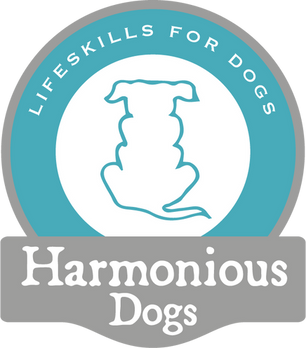
www.harmoniousdogs.co.uk
copyright Harmonious Dogs
Please note that throughout this booklet the puppy is always referred to as 'he' for ease of reading. The advice is for both sexes.
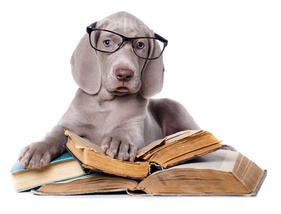
Introduction How Dogs Learn
Dogs learn through socialisation, habituation, and habit.
Dogs see the world through their nose and part of the dog's brain
is developed to analyse smells. Dogs have up to 300 million
olfactory receptors in their nose, compared to us humans who
have 6 million receptors.
Dogs are experts at reading body language and have extremely
fast reactive time in reacting to what is going on around them,
therefore it is important we need to learn how to read their
signals and interpret their behaviour, to ensure we are able to
provide a safe, secure, family network for everyone in the
household.
The Psychology of learning in dogs can be compared to that of
other species. A dog will always do what is in his best interest at
any one time, They learn through studying us, their guardians,
any children, and other canine members of the family unit
intently, quickly settling into their own place within the family.
1
Modern training methods used when working with dogs help
them to learn quickly and effectively. Anything that comes
naturally to a dog that is rewarded is likely to be learned
quickly. The level of motivation for the reward can affect the
speed at which a dog masters a new task, therefore if we use
positive rewards that are of higher value to the dog, the task will
be learnt effectively.
When using positive reward-based training you can also use
toys, play, and praise, and try to reward the behaviours that
please you. If your puppy is lying down quietly and you want to
encourage this quiet behaviour, then reward it. These are often
missed opportunities to reinforce good behaviour. Your timing
with a reward is very important, your puppy will learn quickly if
you are clear and consistent. If you want to give your puppy a
treat for sitting, then give him the reward when his bottom is on
the floor. If you want to reward him for not jumping up then
reward him when all four paws are on the floor.
It is important that everyone in the family is consistent and uses
the same sign language and cue words for each task, otherwise,
your puppy will become confused. Remember to use one word for
each behaviour, for example: use the word 'down' when asking
your puppy to lie down, and use the word 'off' when asking your
puppy to get off the furniture or when jumping up at people. Dogs
do not understand English, but they are experts in ready body
language. When you start training with your puppy, begin using
hand signals as a sign language, when he starts to understand
what you want him to do, add your cue word that you would like
to use. Try not to nag at your puppy or keep repeating words over
and over again otherwise your puppy will feel overwhelmed, he
will begin to switch off and this will prevent him from learning.
2
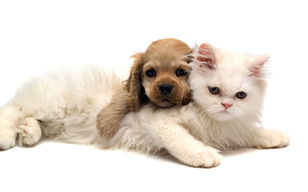
What is puppy socialisation?
other breeds of dog play, but this is just one element of your puppy's
socialising journey.
Learning about environmental factors is also important as we need to
teach a puppy how to behave in society. These environmental factors
are things like traffic, household appliances, children playing, cats and
other animals, the list goes on.
There is a sensitive period for socialisation and this is up to 16 weeks, so
there is not a lot of time to start socialising your puppy. But done
carefully we can make a big difference to a puppy's future.
Try to make all new experiences a positive one, if your puppy is worried
about something while out, just move on and try again another day, do
not flood your puppy with lots of stimuli in one day.
Remember your puppy is at risk from infection in public areas until his course of vaccinations are complete.
3
It is important for your puppy to mix with other dogs so he can learn how
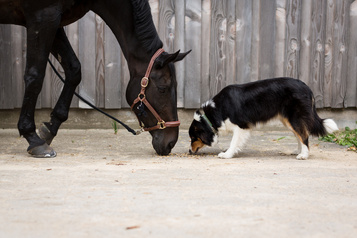
Introducing your puppy to a variety of experiences early on in
his life and making new experiences pleasant is very important.
Be sensible, creative, and calm, and observe your puppy's
behaviour.
If your puppy is happy to find out about the world around him,
then great, however, if your puppy looks uncomfortable or
stressed then don't force him, instead give him time to make up
his own mind.
Larger breeds tend to process the world slower, it takes them
longer to process information so give them more time, and allow
them to observe from a distance. Happy experiences are
essential for developing a friendly well-adjusted character in a
puppy.
Make regular trips to the vet just to let your puppy meet the
staff, teach him how to go on the scales, and be weighed without
force. Take along your treats to make visits a positive one.
Introduce your puppy to a variety of noises, begin with a quiet
place, and gradually progress onto busier environments, this
will help to build his confidence, and feel safe and comfortable
with you.
4
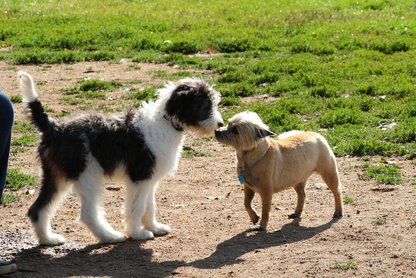
Allowing your puppy to greet other dogs is ok if the other dog is
happy with this, not all dogs are happy being approached by a
bouncy enthusiastic puppy.
If your puppy is on lead try to keep the lead loose, this will help
your puppy to use their body language correctly with
approaching other dogs. A tighten tense lead can make your
puppy feel anxious.
5
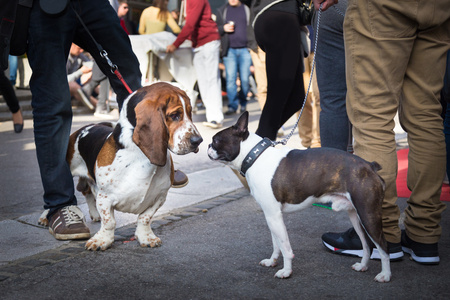
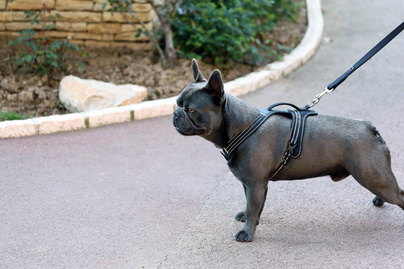
Having your puppy in a harness will allow him to use his body
language more effectively around unknown dogs than if they are
wearing just a collar and lead. Remember the 3-second rule,
after 3 seconds guide your puppy away so the greeting does not
get too exciting and your puppy starts to jump up, this is for
people and dogs.
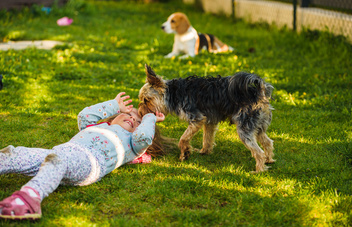
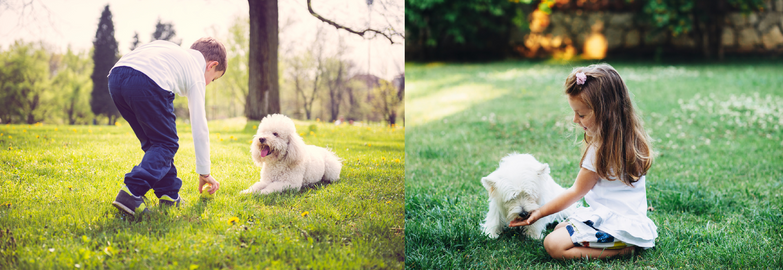
Supervise children when they are around your puppy. Do not
allow children to roll about on the floor playing rough and
tumble games, one day your puppy will be older, stronger and
more confident and will still want to play roughly, this can be
dangerous and is often the time when children will get hurt. This
kind of play can also lock dogs into a world of juvenile behaviour
and can easily become a learnt behaviour that is carried on well
into adulthood.
Instead, play useful games, teach your puppy to find hidden toys
and invest in some modern interactive dog games. Get the
children involved with caring for the puppy, give them a
responsibility, teach them about feeding, grooming, and
walking, set a good example and show them how to behave
around a puppy sensibly.
6
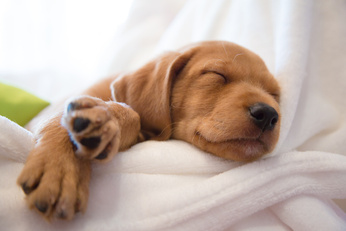
Leaving and Greeting your
Puppy
Learning to be alone is a very important stage for a puppy, but
also very scary for a puppy. Dogs are a sociable species and do
not like to be left alone.
Bringing a puppy home away from his littermates and the
security of his mum is very frightening, so it is no wonder
puppies struggle to settle at night.
If you want your puppy to sleep downstairs then this is where
you need to start and continue, but be prepared for a few
sleepless nights and in some cases longer, you can sleep
downstairs with your puppy so they don't feel so alone and they
build in confidence.
Some people like to use crates, these can be useful but do need to
be introduced correctly.
When leaving your puppy during the day, leave the house calmly
without making a fuss. Leave plenty of things to occupy him, a
Kong filled with food and his own toys that are safe for him to
chew on, and provide him with a suitable bed of his own, these
things can all help your puppy to cope with learning to be alone.
7
When you return home say hello briefly and calmly to your
puppy, and when you are ready to greet him, do so quietly and
calmly and take him straight out to go to the toilet.
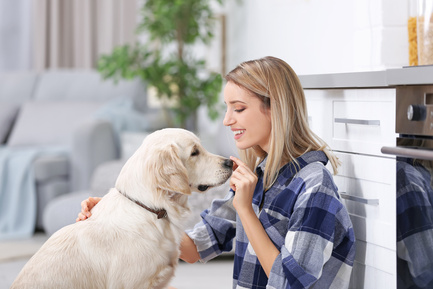
When a dog leaves the house, they are normally going on a walk
or some other exciting activity like training or it might be going
to the vet which some dogs love. So, when our dogs see us leave
the house they have no idea where we are going, they do not
understand we need to work or take the children to school or go
shopping, and they feel like they may be missing out on an
exciting activity.
Take your puppy out in the car just for a car journey and then
home again, so they can see that leaving the house does not
mean lots of excitement.
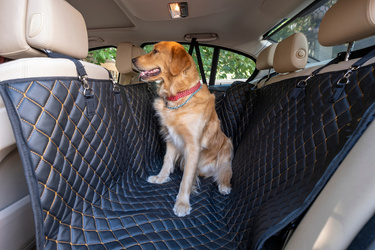
8
8
9
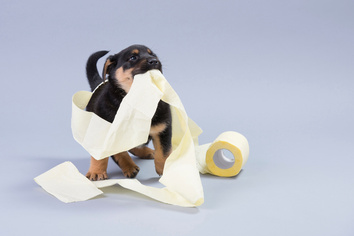
Toilet Training
Puppies don't have bladder or bowel control until about 16-18
weeks and some breeds can be longer. Toilet training is a
developmental stage that every puppy goes through.
Take puppy outside to go to the toilet regularly:
After eating
Drinking
When he wakes up
After playing
After a training session
And once every hour
Try to develop a routine, this way your puppy will learn more
quickly. Always go out with him, even if it is raining, and stay
with him, and praise him when he goes to the toilet.
learn to read your puppy's body language and look for cues that
he needs to relieve himself, such as sniffing the ground or
becoming restless. It is important to take him out to the toilet
before you leave the house and when returning home.
Never punish your puppy for toileting in the house, all this will
do is teach him not to go toilet in front of you and find a place to
hide to go to the toilet where you will not see him.
When cleaning any accidents, you can use a biological washing
liquid or a solution from your pet shop or vet, which will break
down the enzymes in the urine to remove the smell for your
puppy and will help to prevent him from going to the same place
to toilet.
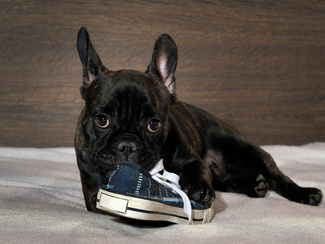
Chewing and Biting
Puppies go through teething much like human children go
through teething and this can be a painful time.
At about 6-8 weeks they will have 28 baby teeth, and at about 4
months old the baby teeth start to fall out making room for the
big adult teeth to cut through. By the time your puppy is about 6
months old, he will have all his adult teeth, but the teething
process can be very painful and create the need to chew more.
All Puppies go through a stage of mouthing and biting this is
completely normal and natural behaviour for puppies, they have
sharp little needle teeth and need to learn how to inhibit a bite,
which means he needs to learn how to control their jaw and be
gentle with his teeth around humans and other animals.
Teach your puppy to chew and play on their own toys, not on our
hands, try not to become frustrated or create an issue with your
puppy if he is mouthing or biting on your hands, instead give him
something he can chew and bite on.
To help with chewing and biting, provide your puppy with:
A variety of different textures to explore with his mouth.
Offer both soft and hard toys.
Interactive games or a Kong filled with his own food.
frozen carrot.
soaking a raggy rope and then freezing it.
Natural chews.
10
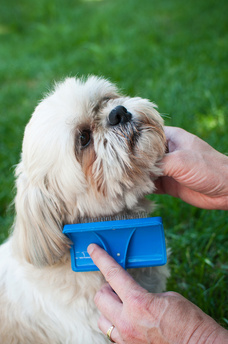
Grooming and Handling your puppy
It is important to start any handling or grooming using force-
free, as any handling can encourage biting especially when
restrained. Puppies struggle to stand still for too long so to help
them you can use:
A natural chew.
Filled Kong.
Licky mat with some paste on it.
Holding treats in your hand and releasing them slowly.
Using these things will help to distract your puppy from the
brush or you be able to examine them.
Do not flood your puppy with prolonged sessions of handling and
grooming, do little sessions to help them become more confident
with being handled.
If your puppy has a coat that will need to be professionally
groomed, book an appointment with a groomer now, who will
take the time to introduce him to this kind of environment before
his proper groom.
11
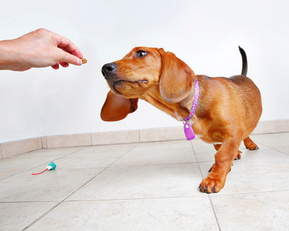
Training
Choosing the Right Training Reward
Most puppies are motivated by food. We use training treat in
values, for example:
A dry biscuit might be worth £1.00
A little moist training treat might be £3.00
A piece of cheese or sausage may be worth £5.00
A tasty piece of chicken or liver may be worth £50.00
This will all depend on what your puppy sees as high value each
day as this may change from day to day.
Reward Values:
When coming to training, we would recommend bringing 3
different values of rewards rather than just one, this way when
training your puppy, your puppy will not know what treat is
coming and will try to work harder for the higher value reward.
Dry puppy food is very low value because they eat this every
day as their meal.
at home as a general treat.
Small moist training treats are medium value, as you may
use these to do some training at home with no distractions.
your puppy might find cheese, sausages, chicken, or liver as a
high value because he does not have this all time.
Toys that are left lying around all day are not rewarding
enough to work for but are fun to play with at home.
Find a high-value toy (a non-squeaky one) that can be use
when on walks or at training with your puppy.
The high-value toy is special and only comes out for you to
play with your puppy and then gets put away until the next
training session.
12
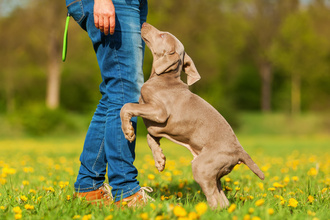
Jumping up
Puppies love to jump and climb and some breeds more than
others, and puppies are just beginning to learn about self-control
and self-calm so they find it very difficult not to jump up.
However, if we continue to let them greet us in this way the
behaviour becomes self-rewarding and learned as it is now
something they enjoy and gets your attention.
Here are some guidelines to help with the jumping up:
When leaving and greeting your puppy, do so calmly, to help
your puppy to be calm.
Ignore any jumping up when you are greeting your puppy, by
withdrawing any attention.
Fold your arms and turn away or walk away from your puppy
and busy yourself with something else.
Do not push your puppy down or shout at him, as he will see
this as attention and a challenging game that may make the
behaviour worse.
Reward all four paws on the floor.
You will need to take control of things when visitors arrive,
by popping your puppy behind a stairgate, so they do not get
the opotunity to jump up on visitors
13
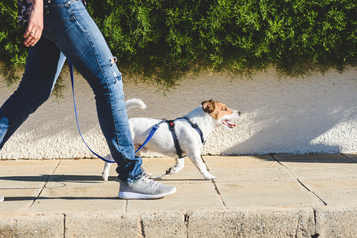
Walking Together
Puppies are not born with the ability to walk on a loose lead.
Puppies that pull excessively can cause an injury to their
neck, spine, shoulders, and hips.
Confident puppies will pull more as they want to investigate
a new smell, and greet people and other animals.
Your aim to help with pulling is to work towards your puppy
having an awareness of being on a lead and not pulling you to
where they want to go.
Using a harness gives you more control over your puppy's
body weight and is giving a signal from the spine, not the
neck. This is kinder and less likely to cause an injury if used
correctly.
Practice walking together with your puppy on a loose lead as
much as possible.
Start by encouraging your puppy to follow a treat in your
hand and gradually release small amounts of treats to your
puppy, when he is walking near you with the lead loose.
Next start rewarding him randomly with every few steps and
dropping the treat on the floor for him, as this will help stop
the jumping and grabbing your hand for the treats.
Remember you are teaching a loose lead not competition heal work.
14
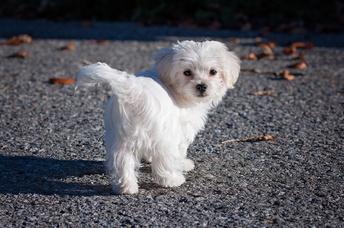
Stay near by and check in
Letting your puppy off the lead for the first can be scary, but a
young puppy will not go far away from you and especially if you
have a nice high-value tasty treat with you.
Some people use a whistle which can be useful if they are at too
far a distance to call back.
To start with, teach a basic recall:
Have a treat and get your puppy interested in the treat.
Throw the treat away from you.
While he runs off to find the treat crouch down and call him
to you with open arms using a happy tone in your voice.
When he gets to you give him the treat. DO NOT ask him to
sit. (you want to reward the coming back to you not the sit).
Repeat this exercise in another direction.
This recall game will help make your walks more interactive and
make you more fun to be with when on a walk. When out
randomly call your puppy back to you for a treat and sometimes
give him two treats or even three, this way he will not just come
to take the treat and run off again, it will be worth hanging
around just in case there is another treat on offer.
15
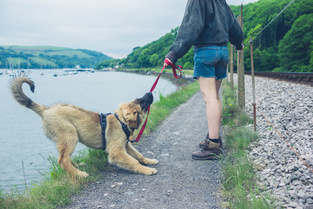
Adolescence and Beyond
Your once cute little puppy will become a teenager. Some young
dogs will sail through adolescence, while others may not.
The important thing to remember is this stage will not last
forever, but we do need to change how we are treating our young
dogs, to help them learn and retain information more easily and
also to make all training sessions stress-free for you and your
teenager.
To help with hormones and boredom, be creative at meal times,
dogs love to seek out and forage for food, this is what they would
naturally do and not be served their food in a bowl every day.
Begin more creative at meal times will give mental stimulation
and they will enjoy using their natural abilities to find food.
Why be creative with feeding?
Dogs love to forage and work for their food.
Gives your dog mental stimulation.
Teaches your dog to problem solve and build confidence.
You spread their daily food allowance throughout the day.
Encourages your dog to eat more slowly which will help aid
digestion.
Can reduce stress and anxiety.
There are lots of different interactive food games on the market.
You can also just scatter feed by throwing some of their food in
the garden.
16
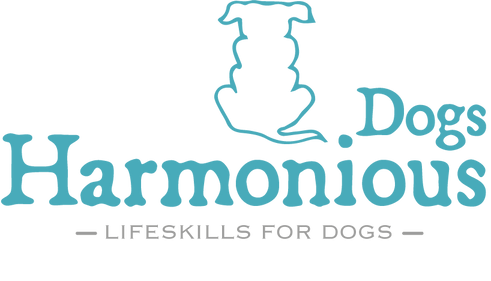

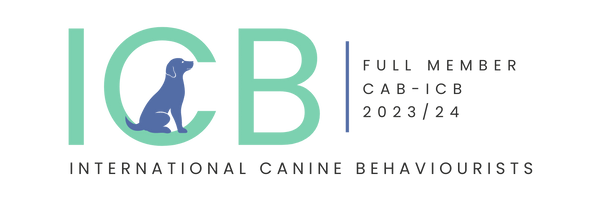
Alison Garforth A.DipCBM MICB
www.harmoniousdogs.co.uk
copyright Harmonious Dogs 2022